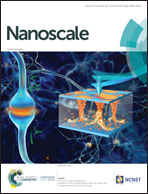Structural origin of the high-performance light-emitting InGaN/AlGaN quantum disks†
Abstract
Ternary III-nitride-based nanowires with highly efficient light-emitting properties are essential for a broad range of applications. By using the selective area molecular-beam epitaxy method, InGaN/AlGaN quantum disks (QDs) embedded in hexagonal GaN nanowires were successfully grown. With the help of atomic-scale-resolved transmission electron microscopy and atom probe tomography, atomic ordering and other related structural information, such as crystallography and local chemistry, have been unambiguously revealed to provide unique insights into the exceptionally strong photoluminescence enhancements. A boomerang-shaped InGaN/AlGaN QD was identified, and atomic-level 1 : 1 periodic chemical ordering within the boomerang shaped AlGaN layers along the c-direction was revealed, confirming the preferential site occupation of Al-atoms. This type of growth provides a strong suppression of the quantum-confined Stark effect and is thus likely a very strong contributor to the exceptional properties. This work therefore enables us to directly establish the key structural elements necessary to understand the exceptionally strong emission exhibited by these materials. Optimization of the configurations of QDs could be an alternative design tool for developing various advanced LED device applications with well-designed structure and desirable optical properties.



 Please wait while we load your content...
Please wait while we load your content...